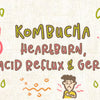Kombucha Mold Guide: How To Identify And Destroy
Kombucha mold is a brewer's worst nightmare, its presence spells the end of the road for the entire brew. Mold is a category of fungi that have a distinctive fuzzy look - they form from multicellular filaments known as hyphae.
While there are many varieties of mold, they can all be identified by their fuzzy texture which resembles small hairs which are thread-like structures.
Mold causes rotting, which is the breakdown of organic materials. In kombucha, the presence of mold indicates that the entire brew and the SCOBY used to ferment it have been contaminated with unwanted and harmful fungi.
How to Identify Mold and Mold Photographs
Mold can be easily confused with a growing baby SCOBY in kombucha or leftover specks of tea leaves. For this reason, we have to look into identifying characteristics to look out for in mold:
By Color
 The color of mold is determined by the type of fungi whereby the most common varieties range in colors from black, green, tan, white to blue. While the hairy filaments might be colorless in some cases, the thread-like structures on which it grows (mycelia) are often colored.
The color of mold is determined by the type of fungi whereby the most common varieties range in colors from black, green, tan, white to blue. While the hairy filaments might be colorless in some cases, the thread-like structures on which it grows (mycelia) are often colored.
Credit: Yeabucha
Shape

Mold typically grows in clumps, circles, or rings with visible thread-like structures (mycelia) at the base. These threads can crisscross from one cluster to another.
The hair-like structures (hyphae), on the other hand, are thin and soft to touch often with a fuzzy texture. Upon maturing, the hyphae will develop spores which are as fine as dust.
Credit: Kombucha Home
Location in the brew

Kombucha mold only grows on the upper surface of the brew, where it can access oxygen. The mold can be found growing as floating colonies or embedded to a floating SCOBY or on the walls of the fermentation jar.
Credit: Organic-Kombucha
Smell
Kombucha mold gives off a distinctive musty odor that’s reminiscent to that of mildew. This is quite different from the yeasty and vinegary smell of raw kombucha. In some cases, this musty odor may be accompanied by the smell of rot. However, do not go around smelling mold as it may already be sporing and these tiny spores can trigger allergic reactions.
What to Do if You Have Mold?
After positively identifying mold in your kombucha, the next step should be to throw it out. This is because kombucha naturally fights off mold growth on its own and the failure of this property indicates an underlying problem with the brew meaning it might not be safe to consume.
Empty The Contents Of The Brewing Jar Down The Drain
The moldy kombucha, as well as the SCOBY, used to brew are contaminated and should be disposed of immediately. This prevents the release of spores which might infect other ongoing fermentation projects.
Thoroughly Clean The Equipment
All brewing equipment that may have come in contact with the contaminated brew should be cleaned thoroughly with boiling water and distilled vinegar. This includes the fermentation jars or bottles, and lids. Rinse the equipment with plenty of cold water. It's advisable to avoid using antibacterial soap as any residual antibacterial properties might harm future brews by killing the bacteria culture.
Sterilize The Equipment
In order to ensure that the equipment is free of any mold spores, you should use distilled vinegar or boiling water to sterilize them. This prevents the recurrence of mold growth while using the jars again.
Drying and storage
After sterilizing the fermentation equipment, allow it to dry naturally before storing them in a dry environment away from any contaminants.
How to Prevent Mold Growth
Keep Your Equipment Clean
Mold spores are lightweight, and they float in the air and when they land on moist surfaces with nutrients, they quickly establish a mold colony. All kombucha brewing equipment should be kept clean at all times as any dirty surfaces on them might come into contact with mold spores leading to mold growth. Avoid spilling kombucha on the jar rims and outer walls to avoid contamination. Any spillages during the process should be cleaned with a cloth dipped in distilled white vinegar.
Cover The Brew
Fermenting kombucha should always be covered with a thickly woven cotton cloth that can allow gases to pass through freely while also keeping out contaminants such as mold spores. Alternatively, you can use a coffee filter to cover the brew. It's recommended using a rubber band to hold the cover in place around the mouth of the fermentation jar.
Keep The pH Of The Brew Low
The low pH of kombucha (between 2.5-4) protects the brew from mold growth as the spores, and other bacterial contaminants cannot survive the acidic environment. The pH of kombucha can be kept low by using adequate amounts of starter tea specifically raw kombucha from either a previous brew or from a SCOBY hotel.
In the absence of raw kombucha, you can use distilled vinegar as a starter tea although this will affect the flavor of the final brew. Monitor the pH of kombucha as the brew ferments and if it doesn’t begin to fall after the third day, you can add three tablespoons of distilled white vinegar.
For more information about pH, considerations, alterations and equipment, check out Kombucha And pH: The Complete Guide To Raising And Lowering.
Keep The Brew Within The Optimum Temperature
Kombucha ferments optimally within 68-78ºF (20-25ºC) . During this optimal condition, the yeast culture breaks down sugar into ethanol which is subsequently broken down by the bacteria culture into acetic acid thus maintain the acidic environment. This prevents the growth of mold spores in the brew. When the temperature drops or climbs beyond this optimum range the acetic acid production seizes making it possible for mold to thrive in the brew while also affecting the flavor of the final brew.
During the winter or in cold environments, you can use a kombucha heating mat to keep your brew warm. For more information about kombucha heating mats, considerations and reviews check out Kombucha Heating Mats.
Use Quality Ingredients
Kombucha culture thrives on natural white sugar and nutrients such as caffeine from tea leaves. Keeping the culture well-fed allows it to protect itself from mold growth through acetic acid production naturally.
Avoid using artificial sweeteners that lack the required calorie-based sugars. Tea leaves with added essential oils are also harmful to the SCOBY as they contain antibacterial properties. Chlorinated water should also be avoided when brewing the tea as the chemical is detrimental to the culture.
What Causes Mold Growth in Kombucha?
Unfavorable pH Level
Fermenting kombucha can protect itself naturally by continually producing acetic acid, which prevents mold growth. When this process fails, the pH level will rise beyond 4 making the brew less acidic which allows contaminants such as mold spores to grow in the brew.
Cross-Contamination
Cross-contamination can occur between kombucha and other fermenting projects which might have different yeast cultures. This leads to the transfer of foreign culture from these brews into the kombucha which disrupts the symbiotic balance in the brew hence allowing mold to grow. Cross-contamination can also occur if the kombucha is stored near natural sources of mold or airborne contamination.
Unhygienic Conditions
Failure to observe high hygiene standards during the preparation and brewing stage of kombucha is the main cause of contamination which leads to mold growth. This ranges from using dirty fermentation jars to not washing hands before handling the kombucha.
Common Questions
Can You Drink Kombucha With Mold In It?
No, moldy kombucha is considered harmful as mold can produce mold spores, which could trigger allergic reactions. Some mold cultures also produce mycotoxins which are toxic metabolites. These are capable of causing disease and even death when consumed.
Can You Be Allergic To Kombucha Mold?
Yes, kombucha mold produces spores that float in the air and trigger allergic reactions when inhaled.
Can You Save A Moldy SCOBY?
It's not recommended trying to save a moldy SCOBY as this might cause mold infestation in any future brews that the infected SCOBY is used to brew.

 The color of mold is determined by the type of fungi whereby the most common varieties range in colors from black, green, tan, white to blue. While the hairy filaments might be colorless in some cases, the thread-like structures on which it grows (mycelia) are often colored.
The color of mold is determined by the type of fungi whereby the most common varieties range in colors from black, green, tan, white to blue. While the hairy filaments might be colorless in some cases, the thread-like structures on which it grows (mycelia) are often colored.





